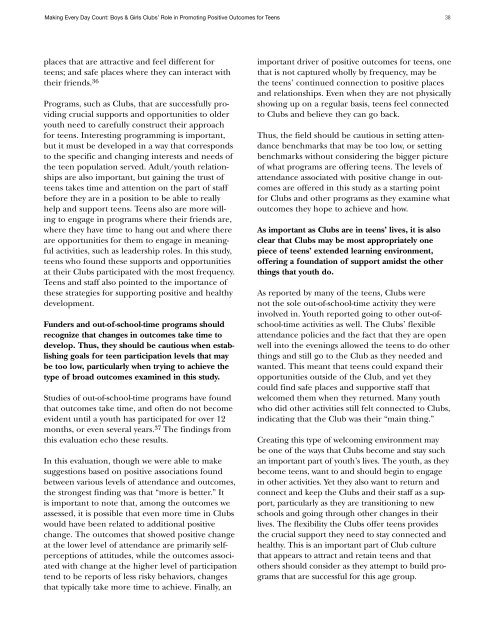Making Every Day Count - Teens
Making Every Day Count - Teens
Making Every Day Count - Teens
Create successful ePaper yourself
Turn your PDF publications into a flip-book with our unique Google optimized e-Paper software.
<strong>Making</strong> <strong>Every</strong> <strong>Day</strong> <strong>Count</strong>: Boys & Girls Clubs’ Role in Promoting Positive Outcomes for <strong>Teens</strong> 38places that are attractive and feel different forteens; and safe places where they can interact withtheir friends. 36Programs, such as Clubs, that are successfully providingcrucial supports and opportunities to olderyouth need to carefully construct their approachfor teens. Interesting programming is important,but it must be developed in a way that correspondsto the specific and changing interests and needs ofthe teen population served. Adult/youth relationshipsare also important, but gaining the trust ofteens takes time and attention on the part of staffbefore they are in a position to be able to reallyhelp and support teens. <strong>Teens</strong> also are more willingto engage in programs where their friends are,where they have time to hang out and where thereare opportunities for them to engage in meaningfulactivities, such as leadership roles. In this study,teens who found these supports and opportunitiesat their Clubs participated with the most frequency.<strong>Teens</strong> and staff also pointed to the importance ofthese strategies for supporting positive and healthydevelopment.Funders and out-of-school-time programs shouldrecognize that changes in outcomes take time todevelop. Thus, they should be cautious when establishinggoals for teen participation levels that maybe too low, particularly when trying to achieve thetype of broad outcomes examined in this study.Studies of out-of-school-time programs have foundthat outcomes take time, and often do not becomeevident until a youth has participated for over 12months, or even several years. 37 The findings fromthis evaluation echo these results.In this evaluation, though we were able to makesuggestions based on positive associations foundbetween various levels of attendance and outcomes,the strongest finding was that “more is better.” Itis important to note that, among the outcomes weassessed, it is possible that even more time in Clubswould have been related to additional positivechange. The outcomes that showed positive changeat the lower level of attendance are primarily selfperceptionsof attitudes, while the outcomes associatedwith change at the higher level of participationtend to be reports of less risky behaviors, changesthat typically take more time to achieve. Finally, animportant driver of positive outcomes for teens, onethat is not captured wholly by frequency, may bethe teens’ continued connection to positive placesand relationships. Even when they are not physicallyshowing up on a regular basis, teens feel connectedto Clubs and believe they can go back.Thus, the field should be cautious in setting attendancebenchmarks that may be too low, or settingbenchmarks without considering the bigger pictureof what programs are offering teens. The levels ofattendance associated with positive change in outcomesare offered in this study as a starting pointfor Clubs and other programs as they examine whatoutcomes they hope to achieve and how.As important as Clubs are in teens’ lives, it is alsoclear that Clubs may be most appropriately onepiece of teens’ extended learning environment,offering a foundation of support amidst the otherthings that youth do.As reported by many of the teens, Clubs werenot the sole out-of-school-time activity they wereinvolved in. Youth reported going to other out-ofschool-timeactivities as well. The Clubs’ flexibleattendance policies and the fact that they are openwell into the evenings allowed the teens to do otherthings and still go to the Club as they needed andwanted. This meant that teens could expand theiropportunities outside of the Club, and yet theycould find safe places and supportive staff thatwelcomed them when they returned. Many youthwho did other activities still felt connected to Clubs,indicating that the Club was their “main thing.”Creating this type of welcoming environment maybe one of the ways that Clubs become and stay suchan important part of youth’s lives. The youth, as theybecome teens, want to and should begin to engagein other activities. Yet they also want to return andconnect and keep the Clubs and their staff as a support,particularly as they are transitioning to newschools and going through other changes in theirlives. The flexibility the Clubs offer teens providesthe crucial support they need to stay connected andhealthy. This is an important part of Club culturethat appears to attract and retain teens and thatothers should consider as they attempt to build programsthat are successful for this age group.


